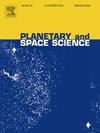潜在的基岩暴露Schrödinger撞击熔融板和/或火山口底断裂系统和火山口内的多晶撞击角砾岩
IF 1.7
4区 物理与天体物理
Q3 ASTRONOMY & ASTROPHYSICS
引用次数: 0
摘要
Schrödinger撞击盆地为未来的勘探提供了重要的地质目标,包括撞击熔体,从月球地壳深处暴露出的数公里长的岩浆岩,火山海,火山碎屑灰烬矿床,潜在的地幔包体,以及用于检查南极-艾特肯巨型盆地近边缘结构的地球物理环境。“勘测者”、“游行者”和“阿波罗”计划都证实,月球表面不断受到陨石坑形成过程的影响,减少了露头的可用性,而露头是地球上地质学家用来作为行星演化最可靠信息来源的关键基岩。月球勘测轨道相机(LROC)的月球表面图像提供了识别月球上基岩暴露所需的数据,并在适合未来探索的位置跟踪导致岩石暴露的巨石。其中一个这样的岩石暴露发生在Schrödinger撞击盆地的火山口内。我们考虑了关于其起源的六个可行假设,并得出结论,它可能代表了Schrödinger撞击事件产生的撞击熔体和/或撞击角砾岩的基岩暴露,或者,与喷口火山碎屑起源相关的原始熔岩。在盆地的其他地方,这些单元被风化层和较年轻的火山沉积物所覆盖,火山口底部裂缝的开放和火山物质的火山碎屑喷发通过撞击或喷发岩性清除了垂直暴露,今天仍然可以进行勘探。本文章由计算机程序翻译,如有差异,请以英文原文为准。
Potential bedrock exposures of Schrödinger impact melt sheet and/or polymict impact breccias within a crater floor fracture system and volcanic vent
The Schrödinger impact basin provides significant geological targets for future exploration, including impact melts, multi-kilometer-long exposures of magmatic rocks from deep within the lunar crust, volcanic mare, pyroclastic ash deposits, potentially with mantle xenoliths, and a geophysical setting for examining the near-rim structure of the South Pole-Aitken mega-basin. Surveyor, Ranger, and Apollo programs confirmed that constant gardening of the lunar surface by impact cratering processes reduces the availability of outcrops, which are those key bedrock exposures that geologists on Earth use as the most reliable sources of information about planetary evolution. Lunar Reconnaissance Orbiter Camera (LROC) images of the lunar surface are providing data needed to identify bedrock exposures on the Moon, and tracked boulders leading to rock exposures, in locations suitable for future exploration. One such rocky exposure occurs within a volcanic vent within the Schrödinger impact basin. We consider six working hypotheses for its origin and conclude it likely represents a bedrock exposure of impact melt and/or impact breccia produced by the Schrödinger impact event or, alternatively, pristine lava rock associated with the vent's pyroclastic origin. While elsewhere in the basin those units are covered with regolith and younger volcanic deposits, the opening of a crater floor fracture and pyroclastic eruption of volcanic material cleared a vertical exposure through the impact or eruptive lithologies, which remain accessible for exploration today.
求助全文
通过发布文献求助,成功后即可免费获取论文全文。
去求助
来源期刊

Planetary and Space Science
地学天文-天文与天体物理
CiteScore
5.40
自引率
4.20%
发文量
126
审稿时长
15 weeks
期刊介绍:
Planetary and Space Science publishes original articles as well as short communications (letters). Ground-based and space-borne instrumentation and laboratory simulation of solar system processes are included. The following fields of planetary and solar system research are covered:
• Celestial mechanics, including dynamical evolution of the solar system, gravitational captures and resonances, relativistic effects, tracking and dynamics
• Cosmochemistry and origin, including all aspects of the formation and initial physical and chemical evolution of the solar system
• Terrestrial planets and satellites, including the physics of the interiors, geology and morphology of the surfaces, tectonics, mineralogy and dating
• Outer planets and satellites, including formation and evolution, remote sensing at all wavelengths and in situ measurements
• Planetary atmospheres, including formation and evolution, circulation and meteorology, boundary layers, remote sensing and laboratory simulation
• Planetary magnetospheres and ionospheres, including origin of magnetic fields, magnetospheric plasma and radiation belts, and their interaction with the sun, the solar wind and satellites
• Small bodies, dust and rings, including asteroids, comets and zodiacal light and their interaction with the solar radiation and the solar wind
• Exobiology, including origin of life, detection of planetary ecosystems and pre-biological phenomena in the solar system and laboratory simulations
• Extrasolar systems, including the detection and/or the detectability of exoplanets and planetary systems, their formation and evolution, the physical and chemical properties of the exoplanets
• History of planetary and space research
 求助内容:
求助内容: 应助结果提醒方式:
应助结果提醒方式:


